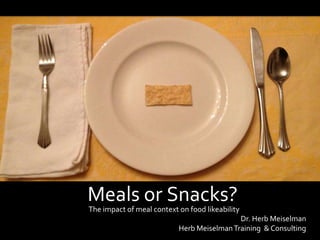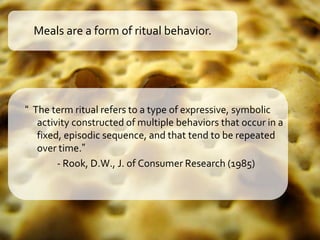Meals vs. Snacks - Presentation at Institut Paul Bocuse
- 1. h|m ┬® Herb Meiselman Training & Consulting Services Meals or Snacks? Dr. Herb Meiselman Herb MeiselmanTraining & Consulting The impact of meal context on food likeability
- 2. h|m ┬® Herb Meiselman Training & Consulting Servicesh|m ┬® Herb Meiselman Training & Consulting Services Herb Meiselman, Ph.D. Scientific Committee, Institut Paul Bocuse, France Research Committee, Culinary Institute of America, USA IMPACT of MEAL CONTEXT Providing food in meals enhances liking scores over foods served individually in laboratory small portions (King et al, 2004, 2007) Providing food in meals rather than isocaloric snacks produces less eating following a meal than a snack. (Capaldi et al, 2006) The cognitive features of foods, their context, influence both liking and intake. The natural context of foods is a meal context.
- 3. h|m ┬® Herb Meiselman Training & Consulting Services MCCORMICK STUDIES ŌĆō MeanValues for Overall Meal and Meal Components AcrossTests Test Meal Component Test 1 Traditional (N=104) Test 2 Meal (N=93) Overall -- 7.5a Salad 7.0c 7.5abc Pizza 7.2ab 7.2ab Tea 5.9b 7.0a Within rows, means sharing letters are not significantly different. King et al, 2004
- 4. h|m ┬® Herb Meiselman Training & Consulting Servicesh|m ┬® Herb Meiselman Training & Consulting Services Meals are a form of ritual behavior. ŌĆ£ The term ritual refers to a type of expressive, symbolic activity constructed of multiple behaviors that occur in a fixed, episodic sequence, and that tend to be repeated over time.ŌĆØ - Rook, D.W., J. of Consumer Research (1985)
- 5. h|m ┬® Herb Meiselman Training & Consulting Services ŌĆ£We have reviewed abundant evidence, linguistic, culinary, practical, and memorial, that the meal is a special unit of eating at the psychological level. It is the basic or privileged unit... Both our day and our thinking are organized in terms of meals.ŌĆØ - Pliner and Rozin (2000), in Meiselman, H.L. (Ed) Dimensions of the Meal Meal = the basic unit of eating
- 6. h|m ┬® Herb Meiselman Training & Consulting Services Four terms to describe eating: ŌĆó A food event is an occasion when food is eaten. ŌĆó A structured event is a social occasion organized by rules concerning time, place, and sequence of action. ŌĆó Food eaten as part of a structured event is a meal. A meal observes the rules of combination and sequence. ŌĆó A snack is an unstructured food event without any rules of combination and sequence. Source: Douglas, M & Nicod, M (1974), New Society, 30, 744-747 Structure of British Meals
- 7. h|m ┬® Herb Meiselman Training & Consulting Services Gatenby, 1997Self reported by subjectNo predefined concept De Castro, 1993210 or 420 or 840 kJ + 15ŌƤ or 45ŌƤ interval time Energy content + interval time since last eating event Skinner et al., 1985 More than one single foodFood quality Presence of fellow eatersSocial interaction Consumption of>375 kcalEnergy content Fabry et al., 1964 and others Eating events in theTime of consumption AuthorMeal defined asCriteria Criteria for the Definition of a Meal Rotenberg, 1981 Bernstein et al., 1981 morning, at midday and in the evening Ref: Oltersdorf et al, 1999, Appetite
- 8. h|m ┬® Herb Meiselman Training & Consulting Servicesh|m ┬® Herb Meiselman Training & Consulting Services Criteria for Proper Meals ’é¦ Social, especially nuclear family. ’é¦ Duration, enough time for eating and socializing. ’é¦ Location, normally at home. Mestdag, I. (2005) Appetite, 45, 62-74.
- 9. h|m ┬® Herb Meiselman Training & Consulting Services Criteria for Proper Meals Individual Social Private Public - Eating alone at home - Snack on the street - Lunch at the workbench - Individual meal at a restaurant - Family meal at home - Meal at friendsŌĆÖ home - Meal with friends at restaurant - Lunch with colleaguesSource: Kjaernes (2001),Table 1-1, Page 35
- 10. h|m ┬® Herb Meiselman Training & Consulting Services Criteria for Proper Meals ŌĆ£We could simply use concepts like ŌĆ£dinnerŌĆØ, ŌĆ£lunchŌĆØ, and ŌĆ£main mealŌĆØ implicitly meaning hot meals at certain hours for our questionnaire. Rather we had to strip such culturally laden concepts of their nation- or cultural-specific garments. In our deconstruction process we decide to ask for ŌĆ£eating eventsŌĆØ, i.e. every occasion of eating somethingŌĆ”ŌĆØ Kjaernes (2001), Page 39
- 11. h|m ┬® Herb Meiselman Training & Consulting Servicesh|m ┬® Herb Meiselman Training & Consulting Services French Meals Stable three meal pattern (INPES 2004 survey): 90.2 % report three meals the previous day 82-85% for people < 30 years ’é¦ Breakfast: Petit dejeuner early morning, 94.5% report having, 15 min. ’é¦ 3-4 course lunch: Dejeuner (diner) 1200-1400, 96.9% report having, 38 min. ’é¦ 2 course dinner: Diner (souper) 1900-?, 40 min. Grignon and Grignon, 2009
- 12. h|m ┬® Herb Meiselman Training & Consulting Servicesh|m ┬® Herb Meiselman Training & Consulting Services Validation of a buffet meal design in an experimental restaurant. Allirot, X et al, 2012, Appetite
- 13. h|m ┬® Herb Meiselman Training & Consulting Services Wansink et al (2010) Meal Snack Social/alone social alone Cloth/Paper napkins cloth paper Longer/shorter long short Ceramic/paper plates ceramic paper Sit/Stand sit stand Hi cost/Lo cost food hi cost lo cost Large/small portion large small Hi/Lo quality food hi quality lo quality Hi/Lo quantity food hi quantity lo quantity Prepared/Packaged food prepared packaged Healthy/Unhealthy food healthy unhealthy Number of items/variety hi variety lo variety food temperature hot cold CriticalVariables for Meals and Snacks
- 14. h|m ┬® Herb Meiselman Training & Consulting Services Cardello, Lawless, & Meiselman (unpub) Meal Snack Beverages inclusion beverage no beverage Level of satiation satiating not satiating Eating times fixed anytime Eating between meals no yes Food compatibility compatible not compatible Color variety color variety no color variety Family traditions show at meals traditions no traditions CriticalVariables for Meals and Snacks
- 15. h|m ┬® Herb Meiselman Training & Consulting Services To download a copy of these slides, complete with full references and photo credits, or to provide feedback (Be nice!) visit: herbmeiselman.com/slides
- 16. h|m ┬® Herb Meiselman Training & Consulting Services ’é¦ Douglas, M. (1975). Implicit meanings: essays in anthropology. London: Routledge & KeganPaul ’é¦ Douglas, M & Nicod, M (1974), New Society, 30, 744-747 ’é¦ Meiselman, H.L. (Ed.) Dimensions ofThe Meal. Gaithersburg, MD: Aspen, 2000, 344 pp. ’é¦ Meiselman, H.L. (Ed.) Meals in Science and Practice. Cambridge, Woodhead, 2009, 681 pp ’é¦ Mestdag, I. (2005) Appetite, 45, 62-74. ’é¦ Oltersdorf, U., Schlettwein-gsell, D., & Winkler, G. (1999).Assessing eating patternsŌĆö An emerging research topic in nutritional sciences: introduction to the symposium. Appetite, 32, 1ŌĆō7. ’é¦ Pliner, P., Bell, R., Meiselman, H. L., Kinchla, M., & Martins,Y. (2004). A laypersonŌƤs perspective on meals. Food Quality and Preferences, 15, 902. ’é¦ Walker, H. (Ed.) ŌĆ£The MealŌĆØ Proceedings of the Oxford Symposium on Food and Cookery 2001, Prospect Books. ’é¦ Wansink,B., Payne, C.R., and Simizu, M.(2010) Short communication ŌĆ×ŌĆ×Is this a meal or snack?ŌƤŌƤ Situational cues that drive perceptions. Appetite 54, 214ŌĆō216 References
- 17. h|m ┬® Herb Meiselman Training & Consulting Services Creative Credits ║▌║▌▀Żs by David Meiselman Marketing (www.davidmeiselman.com) Photos used under Creative Commons Attribution License listed below. ’é¦ ║▌║▌▀Ż 3 ŌĆō http://foodfamilyfinds.com/my-big-red-kitchen-finds-and-favorites/ ’é¦ ║▌║▌▀Ż 4 - http://www.flickr.com/photos/spindexr/4488359319/ ’é¦ ║▌║▌▀Ż 6 - http://www.flickr.com/photos/50826080@N00/7434095300/ ’é¦ ║▌║▌▀Ż 7 - http://www.flickr.com/photos/julishannon/5636548938 ’é¦ ║▌║▌▀Ż 8 - http://www.flickr.com/photos/apothecary/3459912585/ ’é¦ ║▌║▌▀Żs 9-10 - http://www.flickr.com/photos/dwward/3736496238 ’é¦ ║▌║▌▀Ż 11 - http://www.flickr.com/photos/rosswebsdale/2530851977 ’é¦ ║▌║▌▀Ż 13-14 - http://www.flickr.com/photos/myguitarzz/161457656 ’é¦ ║▌║▌▀Ż 15 - http://www.flickr.com/photos/lifeasart/ ’é¦ ║▌║▌▀Ż 16 - http://www.flickr.com/photos/michaelkuhnphotos/3799491755/ ’é¦ ║▌║▌▀Ż 17 - http://www.flickr.com/photos/davedugdale/4948130073/sizes/l/

















